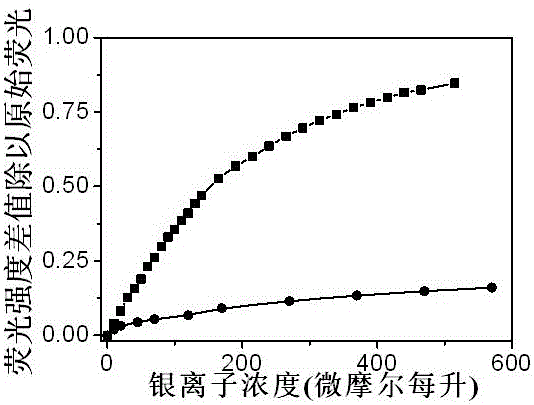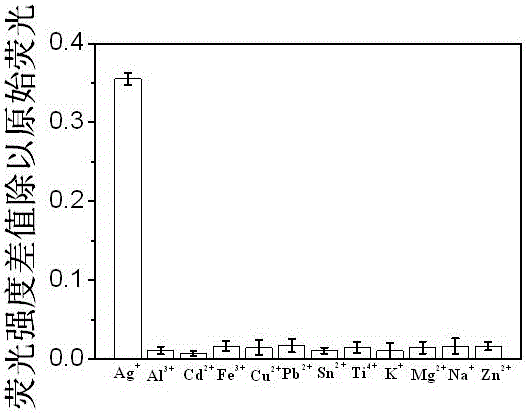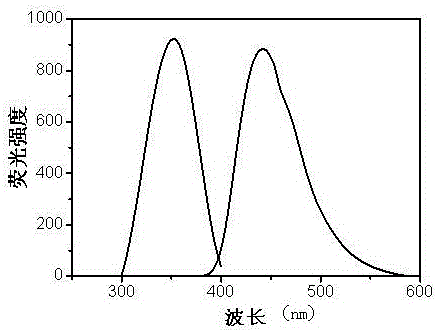Application of water-soluble fluorescent carbon dot in detection of heavy metal silver ion content
A technology of fluorescent carbon dots and silver ions, which is applied in the field of silver ion determination, can solve the problems that limit the prospect of wide application, and achieve the effects of high selectivity, high sensitivity, and simple preparation method
- Summary
- Abstract
- Description
- Claims
- Application Information
AI Technical Summary
Problems solved by technology
Method used
Image
Examples
Embodiment 1
[0028] A method for preparing fluorescent carbon dots (CDs), comprising the following steps:
[0029] Step 1, 0.42 g of anhydrous citric acid was dissolved in 25 mL of ultrapure water, and ultrasonically dissolved to obtain a citric acid solution;
[0030] Step 2, inject 536 μL of ethylenediamine into the bottom of the citric acid solution, transfer it to the polytetrafluoroethylene lining of the reaction kettle, and put the reaction kettle into an oven to make it react to obtain a light yellow solution;
[0031] Step 3, centrifuge the light yellow solution, take the supernatant, and dialysis and purify through the dialysis membrane to obtain fluorescent carbon dots.
[0032] Wherein, the temperature of the oven in step 2 is 160-240° C., and the reaction is 2-8 hours. The centrifugation speed in step 3 is 12,000 rpm for 20 minutes. The dialysis membrane dialysis time in step 3 is 24-48 hours.
[0033] The fluorescent carbon dots of the present invention are installed in a cen...
Embodiment 2
[0036] A kind of application of water-soluble fluorescent carbon dot in detection heavy metal silver ion content, comprises the following steps:
[0037] The first step is to prepare fluorescent carbon dot probes. Take 2 μL of fluorescent carbon dots from Example 1 and add them to a centrifuge tube, then add cysteine (final concentration: 0.5 mM), and dilute with BR buffer solution (pH 7.0) To 2 mL, as a carbon dot / cysteine fluorescent probe, excited with 352 nm wavelength light, measure the fluorescence intensity of the carbon dot / cysteine fluorescent probe at a wavelength of 441 nm, denoted as I 0 ;
[0038] In the second step, take another 2 μL of fluorescent carbon dots from Example 1 and add them to the centrifuge tube, then add cysteine (final concentration: 0.5 mM), dilute to 2 mL with BR buffer solution (pH 7.0) as carbon dots 8 copies of / cysteine fluorescent probes were used to detect the effects of different concentrations of silver ions (final concentrat...
Embodiment 3
[0042] Except that cysteine is not added in the first step, other steps are the same as in Example 2.
[0043] The result is as Figure 4 As shown, through the comparison of the fluorescence signal change curves of carbon dots quenched by silver ions under the conditions of no addition of cysteine and addition of cysteine, it can be seen that the synergistic effect of fluorescent carbon dots and cysteine greatly promotes Ag +The fluorescence quenching effect on the fluorescent carbon dots can effectively improve the Ag + Sensitivity of detection.
PUM
| Property | Measurement | Unit |
|---|---|---|
| wavelength | aaaaa | aaaaa |
Abstract
Description
Claims
Application Information
 Login to View More
Login to View More - Generate Ideas
- Intellectual Property
- Life Sciences
- Materials
- Tech Scout
- Unparalleled Data Quality
- Higher Quality Content
- 60% Fewer Hallucinations
Browse by: Latest US Patents, China's latest patents, Technical Efficacy Thesaurus, Application Domain, Technology Topic, Popular Technical Reports.
© 2025 PatSnap. All rights reserved.Legal|Privacy policy|Modern Slavery Act Transparency Statement|Sitemap|About US| Contact US: help@patsnap.com



